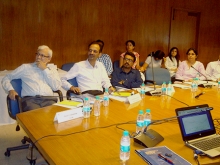NCAER’s annual model predicts that GDP growth rate (GDP market prices at 2011–12 prices) will grow at 7.5 per cent for 2015–16.
NCAER Team presented the Quarterly Review of the Economy at a seminar held on August 18, 2015. The review covers the performance of the Economy in the first quarter of 2015-16 and forecast for the year head.
The seminar commenced with the opening remarks from Rajesh Chadha, followed by presentation on the State of the Economy by Bornali Bhandari & Mythili Bhasnurmath. Invited as discussants for the seminar, Sabyasachi Kar, Associate Professor, IEG and Devendra Kumar Pant, Chief Economist & Senior Director (Head – Public Finance) India Ratings & Research, presented some very interesting annotation and took on the discussions. This was followed by a presentation by Sonalde Desai on “MGNREGA: A Catalyst for Rural Transformation”, a recently released report by NCAER and University of Maryland
Key Highlights:
In the agricultural sector, performance of monsoon rainfall has been extremely satisfactory in the month of June, however, during the month of July there was a slowdown in rainfall activity. Notwithstanding this the deviation from actual rainfall from the normal during the first half of the monsoon season is barely 3.1% (deviation based on rainfall indices computed on the basis of un-irrigated area under foodgrains as weights). As a result, the sown area under all Kharif crops is up by 5% as compared to the corresponding period of last year, led by an increase in area under cereals, pulses, and oilseeds. The outlook for the second phase of monsoon season, however, remains mixed due to differences in forecasts made by the official and private forecasting agencies and much will depend on how monsoon rainfall progresses going forward.
Index of Industrial Production (IIP) registered 3.2% year-on-year growth in the first quarter of 2015–16, maintaining its growth momentum from the fourth quarter of the last fiscal at 3.3%. It was lower than the 4.5% growth in 2014-15:Q1. However, looking at deseasonalised quarterly data, IIP registered 2.1% quarter-on-quarter growth in 2014-15:Q1. It grew negatively in the next two quarters before reviving growth in the fourth quarter at 2.0%. It continued to grow at 2.0% in the first quarter of the current fiscal. These indicate that India is growing but not at higher rates than last year.
The lead indicators of the services sector also indicate trends similar to the last quarter of the previous fiscal year whether it is tourist arrivals, revenue earning goods traffic by railways, cargo handled at major ports, new telephone connections and growth in aggregate deposits. Though, domestic air passenger traffic shows double digit year-on-year growth (19.5%) in 2015–16:Q1.
Inflation rates show a distinctive downward trend driven by fall in global commodity prices and weak demand. Satisfactory rainfall in the first half of the monsoon season has also kept food prices low except for pulses. However, as reported, the RBI Inflationary expectations have edged towards double digits in June 2015. Further, there is an upward movement in the change in the rate of inflation in the first quarter, which if not addressed can potentially affect inflation through higher expectations.
Thus, key policy rates were left unchanged amidst higher household inflationary expectations, slower pace of domestic economic recovery, and uncertainties in the global markets.
On the fiscal sector, revenue receipts have increased in the first quarter of the current fiscal, buoyed by increases in indirect taxation. Capital account plan expenditure has risen in the first quarter of the current fiscal signalling that the government is on track in tackling the infrastructure deficit in the country. Fiscal deficit as a percent of GDP has already reached approximately 50 per cent of its budget estimates, similar to last fiscal.
In sum, satisfactory rainfall in the first half of the south-west monsoon season if sustained may help revive rural demand. Lower inflation due to lower commodity prices and lower food inflation may spur demand. The indicators from the first quarter suggest that agriculture, industry and services are continuing to grow at same or almost similar rates as was the case in the fourth quarter of the previous fiscal. The turbulences in the world economy though add elements uncertainty to the growth path of the Indian economy. Overall, India is predicted to achieve a marginally higher rate of growth of 7.5% than last year (7.3%).












